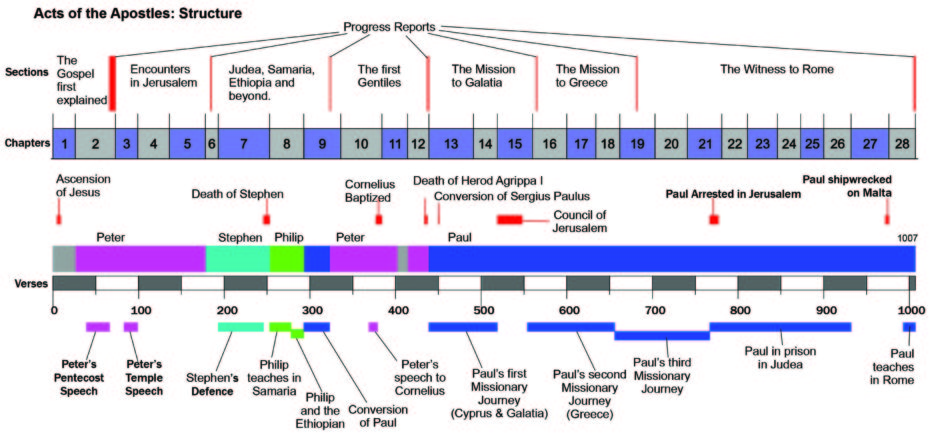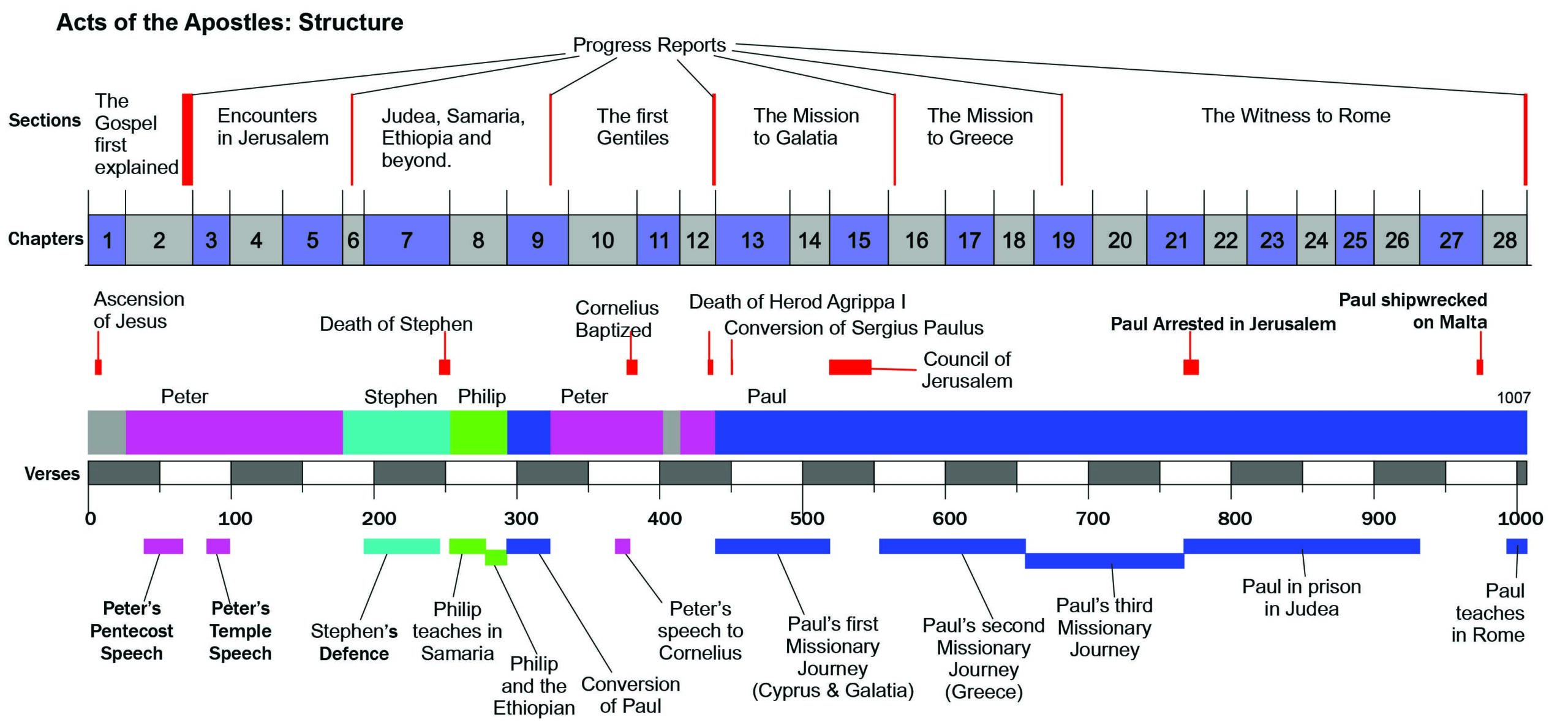This is the third in a series in which we examine this fascinating Bible book. You can catch up with the previous articles at www.gladtidingsmagazine.org.
IF WE ARE to understand a book of the Bible, it’s useful to divide it up into the sections that were intended when it was written. We can then think about what those sections include and what they are there to teach. The Acts of the Apostles can be divided into sections in a number of different ways. Each way of dividing up Acts provides another layer of understanding of the book.

Structure by Progress Reports
Acts contains a number of progress reports which summarise the state of the Christian community at the time. These divide the book into seven sections, each of which has a dominant theme and concludes with the report. The sections are:
1. Introduction to the Gospel: The purpose of Acts and the first proclamation of the Gospel. Acts 1 and 2.
2. Encounters with the Authorities in Jerusalem: The proclamation of the Gospel brings conflict with the leaders of Judaism, and especially the Sadducees. Acts 3:1–6:7.
3. The Gospel Spreads: The Gospel now spreads outside Jerusalem. Stephen is the first person to be killed for his Christianity, Philip takes the Gospel to Samaria and Ethiopia; Saul is converted on the way to Damascus, and changes his name to Paul. There are changes in the working of the community—there are now officials who are not Apostles. Acts 6:8–9:31.
4. The First Gentiles: The Gospel is proclaimed to Cornelius, who is not a Jew. This is such a major step that a conference is held in Jerusalem to decide whether a Gentile can be accepted as a believer. Acts 9:32–12:25.
5. The Mission to Galatia: Paul and Barnabas travel to Cyprus and, after the Governor believes the Gospel, move on to teach in Galatia. This results in congregations where every member is a Gentile. This generates the need for another council in Jerusalem to decide how Gentiles fit within the Christian community.
6. The Mission to Greece: Paul crosses into Europe and proclaims the Gospel in Macedonia and Greece.
7. The Witness to Rome: Paul returns to Jerusalem where he is arrested and finally sent to Rome.
Structure by Main Character
Another way of looking at Acts is to think about the main character in each part of the book. The book begins with events where the narrative is mainly about Peter. There are then sections where the main action concerns Stephen and Philip, followed by the conversion of Paul and then the action of Peter again. The last section of Acts, which is well over half the whole book, concerns the activities of Paul as he takes the Gospel to the various parts of the ancient world: Galatia, Europe and the Roman province of Asia (western Turkey) and then finally on to Rome.
Paul’s progress can be conveniently divided into journeys:
1. The famine relief journey. This is a short Journey from Antioch to Jerusalem to bring assistance to disciples affected by a famine.
2. The First Missionary Journey. Here Paul goes with Barnabas to Cyprus, but after his success in teaching the Gospel to the governor of the island he goes on a further journey through Galatia.
3. The Second Missionary Journey. In this journey Paul sets out from Antioch to Galatia, but then goes on to Troas, from where he crosses into Europe, founding congregations in Macedonia (Philippi, Thessalonica and Berea) before moving on to Athens and Corinth. On his return he briefly calls in at Ephesus, where he leaves some of his companions to proclaim the Gospel.
4. The Third Missionary Journey. Paul sets off to Ephesus where he stays, before moving off into Macedonia and as far as Illyricum (modern Croatia) before visiting Corinth and finally returning to Jerusalem.
5. The Journey to Rome. Paul is arrested in Jerusalem and compelled to appeal for trial before Caesar in Rome. After two years captive in Caesarea he is sent to Rome, where he spends two years before the completion of Acts.
The journeys of Paul are interspersed with various other events: there is a council in Jerusalem after the First Missionary Journey and a prolonged period of captivity in Caesarea while Paul waits to go to Rome. During this captivity Paul is called on to witness to some of the most important people in the area: two Roman governors (Felix and Festus) and the young future King of Judea, Herod Agrippa II (known in Acts as ‘Agrippa’).
The chart on the previous pages plots the structure of Acts on a bar. There are 1007 verses in Acts, and the distance along the bar represents the position of the event in the book.
Overview of the Book of Acts
The chart represents the book of Acts from the beginning (verse 0) to the end (there are 1007 verses altogether). It shows where the various events fit into the book.
• The top of the chart shows Acts’ seven sections divided by progress reports.
• The next line shows the chapters of the book.
• Below this are shown some major landmarks in the book.
• The next line shows the main person in that portion of Acts.
• Next, the number of verses from the start of Acts.
• At the bottom of the chart are the main events of the book: speeches, teaching and journeys.
Some Key People and Events
Stephen—the first follower of Jesus to be killed for his faith. Cornelius—the first Gentile (non-Jew) to be baptized. Paul—converted by Christ on the road to Damascus and sent to preach to the Gentiles. The Council of Jerusalem—where the Apostles decided that Gentiles who wished to become followers of Jesus did not have to follow the Jewish Law.
John Thorpe

